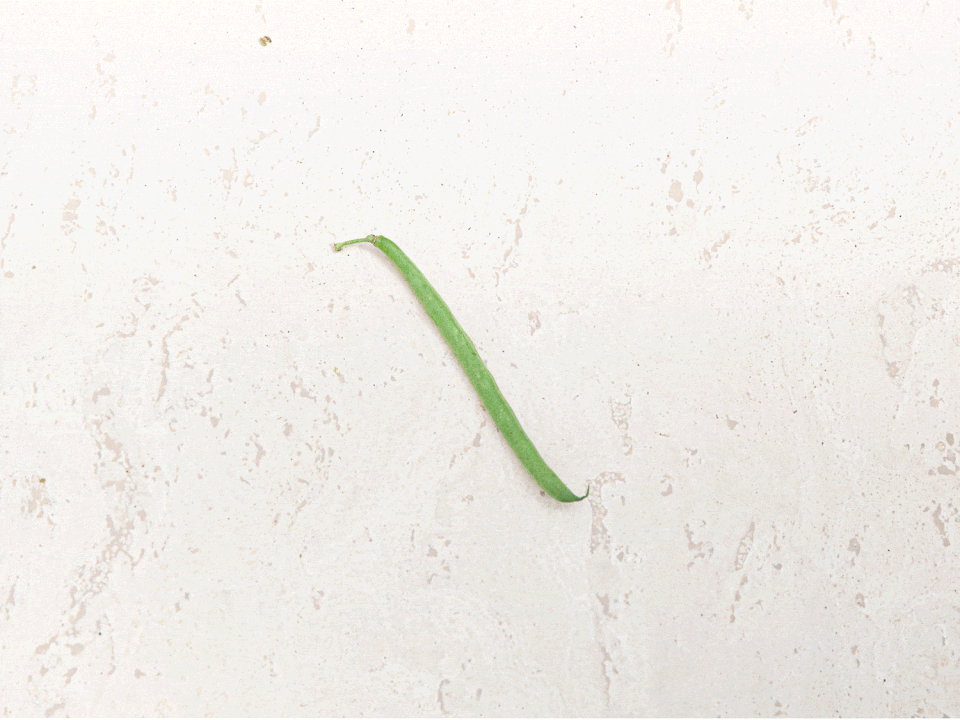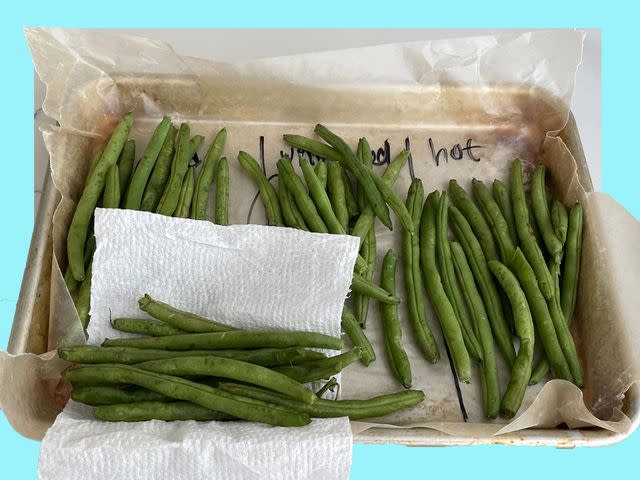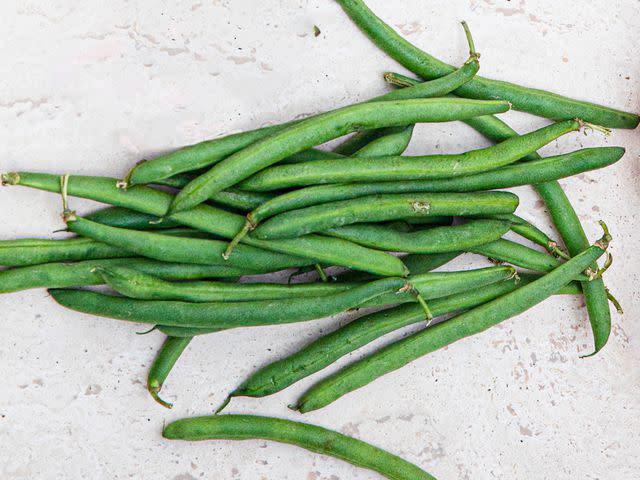How to Store Green Beans
The key to freshness is, in all the ways, totally cool beans.

Serious Eats / Amanda Suarez
TL;DR:
You can keep green beans for north of 10 days if you give them room to breathe after placing them in your fridge unwashed.
Don’t ask me why I love green beans. Don’t ask me why I never don’t have green beans in my home. Don’t ask me why I—alright, fine. Fine! I will forever sing green beans’ praises from rooftops because they are actually one of the very few vegetables I can eat. I’ll spare you the details of years of veggie driven trial-and-error dictated by my medically complicated intestines, but yeah. When I can do greens, beans are one of just a literal few I’m reaching for.
And so I’ll always ride hard for string beans, but I’ll also sometimes need a little break from them and then forget about them at the bottom of my crisper drawer until the very last minute. Such is the nature of vegetables you’re stuck with, I suppose. But this did land me in a very ideal spot: I needed to learn how to preserve green beans for as long as possible both for myself and for work! I was thrilled to use our summer produce package as an excuse to determine once and for all how to store green beans for as long as possible while maintaining their quality, and I got to work.
The Shelf Life of Green Beans
Going into this experiment, I’d truly never thought to treat green beans in any other way than to transport them from wherever I got them (during the summer and fall, that’s usually a farmers market; in spring and winter, either from a grocery store bin or—not gonna lie—pre-bagged) and throw them in the fridge until I was ready to use them. This had been working more or less fine for me, and apart from the occasional shriveled bean, I can't remember a time I’d ever accidentally rotted green beans beyond the point of being fit for consumption. But then, why settle for shriveled green beans if they can remain perky and plump even longer?

Serious Eats / Tess Koman
It turns out it’s been well-established since at least the 1980s that a controlled atmosphere around 4° to 8°C (46°F) is optimal for extending the post-harvest shelf life of green beans for as long as possible—roughly seven to ten days according to this University of Florida paper. The lower end of that temperature scale (4°C) is more likely to be in line with the highest temp in your fridge at home.
Studies have also noted string beans require high levels of humidity for preservation, so between that and the fact that my fridge runs between 1° to 4°C (33.8° to 39.2°F), I knew temperature and humidity management were two of the most important factors I’d be playing with in my own testing. (Related: It turns out we should all have hygrometers, I guess??)
Testing Temperature
Given that these were all scrappy, at-home tests, I worked within the constraints of my home kitchen. I accepted that the ambient temperature in my kitchen would be "room temp," and my cold-storage tests would be limited to what my fridge was set to. I then brought home all the different green beans I could find: handfuls of loose, whole ones from out-in-the-open grocery store bins, pre-trimmed ones sitting right next to the whole ones.
I had no idea what temperature all of those beans had been held at in their journey from field to store, and I certainly did not whip out a thermometer in the middle of a New Jersey Whole Foods produce section—I just bought everything I could find home as quickly as possible, removed any visibly bad beans from the bunch, mixed them all together evenly, and created even batches. From there, I focused on how my fridge’s temperature and my room temperature affected things.
The long and short of it is that by the end of day two, I’d jotted down ‘limp, slight browning’ next to all of my non-refrigerated beans—washed and unwashed—whereas at that point, every batch that remained in the fridge was visibly unchanged. It’s always also just worth keeping in mind that bacteria thrives in the room temperature range, so the visible deterioration in the kitchen heat wasn’t particularly surprising. For comparison, the next batches of green beans to show similar signs of decline were the ones washed and in the crisper; those began to turn on day four.
Testing Humidity Levels
I stored all the beans a few ways: laid flat on a baking sheet totally open to air flow, stood up in deli containers (also exposed to airflow), sealed completely in plastic bags or airtight containers, and on a fridge shelf, in the crisper, and on the counter. Throughout the course of the experiment, all versions of the exposed beans aged similarly well. The sealed ones declined over the course of the week, exhibiting partial softness by day four. The washed and sealed ones in the fridge and crisper went fully wilty-bendy by day five; the unwashed ones sealed tightly maintained their integrity until days eight and nine (more on that in a bit!). Interestingly, none of the exposed beans ever went soft—they always felt like they’d fully, onamonapia-y *snap* if I did try to break them, probably up until day nine.

Serious Eats / Tess Koman
Is Washing Green Beans Ever a Good Idea?
Sure, yeah, they must be washed as you’d wash any produce you plan on consuming. And if you are planning on eating your green beans near-immediately, definitely go for it! But green beans, unlike, say, strawberries, are not prone to rotting quickly; their skins are thicker and the beans are thus more resistant to any mold spores that happen to be on them. Just about everyone who’s written instructions on string bean storage says you shouldn’t wash these bad boys before you store them (and they always say to store them wholly intact and in the fridge). But I don’t trust anyone, nor is there much clarity out there about how washing green beans affects their shelf life, so I decided to run my own tests.
I washed string beans in room-temperature (78°F) water and hot (120°F) tap water, and then left a control batch unwashed. Of the washed batches, I thoroughly dried some and left the rest with water clinging to them. I then divvied them up in sealed plastic bags, open to the air on trays or standing up in open deli containers, and both in the crisper and on a fridge shelf. On top of that, I ran tests in which some batches had lightly damp paper towels wrapped around the green beans and some that didn't. In all I had 16 batches of string beans to test all these variables.

Serious Eats / Amanda Suarez
I quickly learned that introducing moisture into the equation, whether by leaving the beans with washing water clinging to them or via a damp paper towel, was as detrimental to the beans as leaving them out to fend for themselves in the wild of my kitchen during—oops!—the most humid days I’ve ever experienced in my lifetime, let alone during the summer.
By day two, nearly every batch of green beans treated with water, regardless of whether they had been dried or how they had been stored, exhibited the beginning signs of exhaustion. See: puckering, light browning, wilt. None of them were beyond the point of salvaging until day four, when all of the cold water offerings were severely puckered, particularly the ones in the crisper.
Anything unwashed in the crisper fared better through days six-through-eight, but everything outside the drawer just…looked better the whole time. It seemed pretty clear that washing beans and/or storing them in the vegetable crisper was too humid and, therefore, not the move.
In fact, the only batch of beans still standing (at least aesthetically) by day seven were all the unwashed beans on a middle fridge shelf. By day eight, the unwashed beans that were sealed tight and stored on the fridge shelf began to brown. I can’t exactly explain this particular downfall, but it's possible the sealed container simply trapped too much moisture from the beans as they slowly released it over time, which then became undesirable condensation that advanced spoilage.
On day 10, the last beans standing—those that were unwashed and kept exposed to airflow on the fridge shelf finally began to wrinkle, but don’t we all, at a certain point? Still, they remained bright green and mostly aged gracefully through their tips. I would’ve (and did) eat that batch on day 11, trimming the ends and cooking them as I would any other bean. I don’t know that I noticed any difference in taste at all from beans I’d eaten much more quickly in the past.
How to Store Green Beans So They’ll Last Longest, Step-by-Step
TL;DR: You should not wash your string beans before you put them wholly intact in the fridge! If you’re curious about whether you should buy your beans pre-trimmed, or when you should trim them yourself, our editors have written about this previously and have strong feelings on both matters. Here is what you should do regardless:
Whenever possible, buy untrimmed beans.
Remove any already-brown or rotting single beans from the bunch.
Lay them directly on a paper towel–lined tray or place them upright in an open deli container.
Refrigerate.
Wash and trim immediately before eating.

